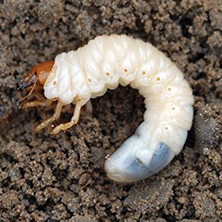Knowing you Have Grubs in your Lawn is Not as Hard as you Think!
Grubs are one of the worst problems you can have in your lawn. Why? Well, because grub problems can spread rapidly and before you have time to deal with them it’s too late. In fact, it’s not always the grubs themselves that cause the most problems. Often, it is the animals that dig in the yard to eat the grubs that can wreak the most havoc.
The reason that animals can cause this type of damage in the first place is that the grubs eat the roots of the grass. Once the roots are eaten the turf is easy to peel back, so the animals peel it back at night and feed on the grubs.

How Do I Know if I Have Grubs?
If your lawn is thick and healthy and you don’t have bare or brown spots, you most likely don’t have a grub problem. If you do have brown spots, or if animals have dug up your lawn it is very easy to see if you have grubs. Just kneel down and try to peel back some of the turf. If it comes up very easy like a carpet that has not been stapled to the floor, then you most likely have grubs.
How Do I Get Rid of Grubs?
If you have a grub problem don’t panic! The best/only way to handle grubs in Ontario is by applying a beneficial nematode during the time when the grub is in its larvae stage. The best time to treat for grubs is in Late August/Early September before their exoskeleton becomes too hard for the nematode to penetrate.
How to Stop the Animals Digging?
Animals are creatures of habit. So, if they have found food on your lawn before they will continually return to the area looking for more. Even though they might not find anything, it won’t stop them from trying and tearing up your lawn in the process. What we’ve found works well without harming our hungry friends is Cayenne pepper. By spicing up the effective area, it gets into their paws and ends up irritating them the next time they clean their face. What typically happens is the animal will start to look for a less irritating spot for their next meal. It sounds silly but it works!
Conclusion
Grubs are not the end of the world, but they should definitely be mitigated each year to reduce the chances of a full-blown infestation. Call us for more information and we’d be happy to help!





